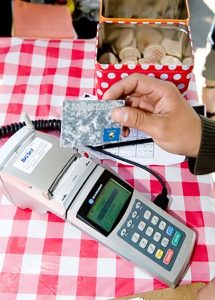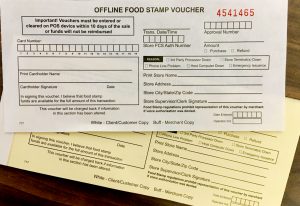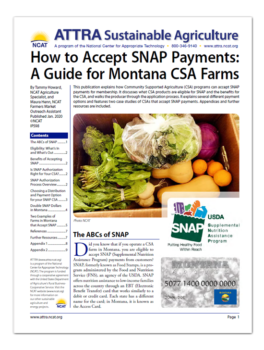How to Accept SNAP Payments: A Guide for Montana CSA Farms
By Tammy Howard, NCAT Agriculture Specialist, and Maura Henn, NCAT Farmers Market Outreach Assistant
Abstract
This publication explains how Community Supported Agriculture (CSA) programs can accept SNAP payments for membership. It discusses what CSA products are eligible for SNAP and the benefits for the CSA, and walks the producer through the application process. It explains several different payment options and features two case studies of CSAs that accept SNAP payments. Appendices and further resources are included.

Photo: NCAT
The ABCs of SNAP
Did you know that if you operate a CSA farm in Montana, you are eligible to accept SNAP (Supplemental Nutrition Assistance Program) payments from customers? SNAP, formerly known as Food Stamps, is a program administered by the Food and Nutrition Service (FNS), an agency of the USDA. SNAP offers nutrition assistance to low-income families across the country through an EBT (Electronic Benefit Transfer) card that works similarly to a debit or credit card. Each state has a different name for the card; in Montana, it is known as the Access Card.
 Payments are directly deposited into your bank account. It takes about two business days for SNAP payments to post to your account, and financial institutions are not allowed to charge you for these deposits.
Payments are directly deposited into your bank account. It takes about two business days for SNAP payments to post to your account, and financial institutions are not allowed to charge you for these deposits.
Eligibility: What’s In and What’s Out
CSA farms produce many staple foods that are SNAP eligible. SNAP-eligible foods and food products include fruits, vegetables, bread, cereal, dairy products, eggs, meat, poultry, and seafood. The starter plants and seeds used to grow staple foods are also SNAP eligible.
Membership fees, administration costs, delivery, deposits, taxes, non-food items, hot foods, prepared foods meant for immediate consumption, alcohol, and tobacco products are not eligible for purchase by SNAP.
Benefits of Accepting SNAP
By becoming SNAP authorized, you create an opportunity for low-income customers to have access to some of the best food around. SNAP customers can connect with the land on which their food is grown, as well as the people who grow it. You help put healthy, locally grown food on SNAP customers’ tables, as well as help build preparation and cooking skills they can use the rest of their lives. According to the Montana DPHHS, more than $171 million was distributed to SNAP recipients in 2017 (MT DPHHS, 2017). By accepting SNAP, you open an additional revenue stream for your CSA and help keep more food dollars in your local community.
Is SNAP Authorization Right for Your CSA?
There are a few things to consider before starting the authorization process.
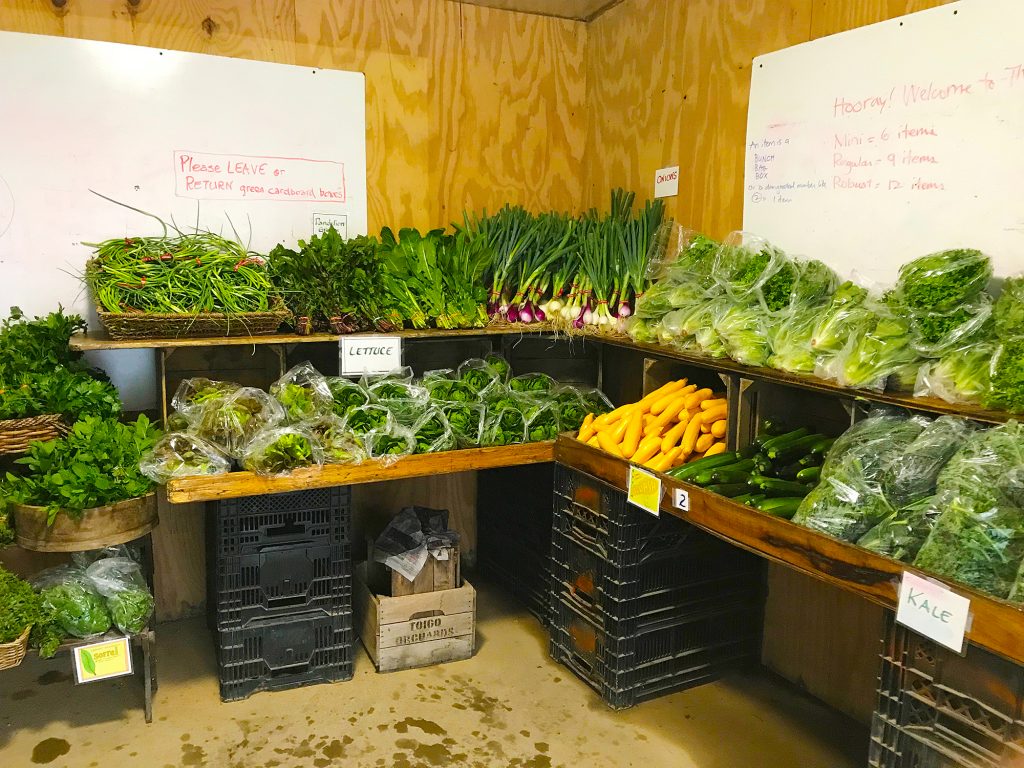
Photo: NCAT
First, SNAP customers typically pay for their weekly share at the time and location you choose for your CSA distribution, using their SNAP cards and secure PINs. The 2014 Farm Bill allows CSAs to collect payments from SNAP customers 14 days before delivery, but SNAP customers cannot pay up-front for the full season like traditional CSA members. A person will need to process the SNAP cards on site. If your farm does not have an in-person delivery system, then adjustments will need to be made to accommodate payment processing. Due to this FNS rule, SNAP customers will have less of a financial stake in the CSA and therefore may pose more of a financial risk as CSA members.
Second, SNAP customers have less of a financial safety net, due to their low-income status. Sometimes SNAP customers run out of their SNAP benefit, especially toward the end of the month. It is important to consider how you will manage this situation, should it arise. Developing a CSA member agreement and having a face-to-face conversation about expectations on behalf of both yourself and the SNAP customer can go a long way in ensuring a successful relationship with all your members throughout the season.
Third, SNAP members generally require more of your time, simply because they will need to pay each time they receive the CSA share.
SNAP Authorization Process Overview
This is a quick overview of the application process. For a complete, step-by-step guide, see How Do I Apply to Accept Benefits?
- Register for a USDA eAuthentication account and create a user ID and password.
- Complete an online application.
- Submit supporting documentation.
- Check application status.
- Wait for authorization.
Plan Ahead: The entire process, from becoming authorized to obtaining equipment, can take four to six weeks. Keep this in mind when planning for your CSA season.
Helpful Hints for the Application
Business Designation: CSAs should choose “Farm Stand/Stall/U-Pick.”
Wholesale: When answering the question, “Do you sell products wholesale to other businesses such as hospitals or restaurants?” farmers should answer “NO.” The temptation is to think of the entire farm operation, but the application is for the CSA operation only.
Total Retail Sales: Only enter the sales from the part of your business for which you will be accepting SNAP. For example, if you are going to accept SNAP for your CSA, you will only report sales from the CSA (do not include farmers markets, wholesale, or other revenue).
Hours of Operation: Your weekly hours of operation are the days and times of your CSA distribution.
Gather Supporting Documents
After you submit your application online, you will see a page describing additional documents you must submit to FNS to complete your application. These documents include the following:
- Document Cover Sheet. You will download and print this at the end of the online application.
- Certification and Signature Statement. You will download, print, and sign this at the end of the online application.
- A color copy of a photo ID (e.g., driver’s license, state-issued photo ID, passport, or military ID) for all owners/officers listed on the application.
- A color copy of Social Security cards or acceptable verification of Social Security number (e.g., tax forms or insurance card) for all owners/officers listed on the application. This information is provided to prevent fraud.
- A copy of your business license. The goal of this requirement is to verify that your business exists, and this can be a little tricky for farmers because they don’t often need a business license. A health permit, food inspection permit, sales tax permit, sellers permit, business license, or business registration from the state have been accepted by FNS.
Wait for Authorization
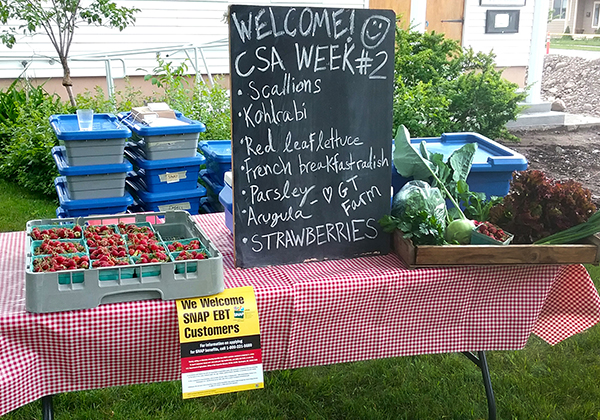
Photo: NCAT
It may take anywhere from two weeks to 45 days for your application to be approved. Once you are approved, FNS will send you an assigned FNS number.
Determine How Your Farm Will Process SNAP Transactions
While you are waiting for authorization, it is a good idea to start researching how your farm will process SNAP payments. SNAP payments can be processed through wired or wireless EBT processing equipment, often referred to as terminals. For a free EBT-only wired or wireless terminal, FNS will typically share your contact information with the State vendor. For all other terminals, you will work with a third-party vendor, which is a service provider that transfers money from the SNAP customer’s account into your farm bank account. If you already accept credit and debit cards, this process will be familiar. For more information on equipment and third-party processors, see the text box below titled “Models for Processing SNAP Payments.”
Choosing a Distribution and Payment Option for your SNAP CSA
There are a few different options when it comes to distribution and payment models. These options vary in cost and mobility. The right option will depend on how your CSA is structured and where your distribution sites are located. The basics of these options are shared below. For more details refer to the Zenger Farm CSA Farmer’s Nationwide Guide to Accepting SNAP/EBT Payments, but keep in mind that the manual was written prior to the 2014 Farm Bill and some information has changed.
Models for Processing SNAP Payments
Selecting SNAP processing equipment and a third-party service provider requires some research, and the cost should be included in the farm’s cash-flow expenses. The equipment can be set up to accept credit and debit cards and is much like the equipment you see at a grocery store checkout. To process a payment, you swipe the customer’s SNAP card, and the customer will enter the PIN on the terminal. Once the transaction is complete, a receipt is printed for the customer and another for your records. Some equipment options allow for the receipt to be sent through email or text message. Wired/wireless terminals that accept credit and debit cards are available from third-party vendors, but there is an additional expense, as shown in Table 1.
Photo: NCAT
For more information and options on SNAP processing equipment, see Appendix 1.
Using Manual Vouchers
Sometimes equipment malfunctions, wireless-device batteries lose their charge, or you run into wireless connectivity issues. In these situations, it is good to have a backup plan to process the SNAP payment, and this is where vouchers are useful. A voucher is carbon-copy receipt provided by the point-of-sale terminal supplier. It is a way to record the transaction and provide a receipt to the SNAP customer at a staffed pick-up site.
The member gives you a SNAP card but instead of swiping it, you make a call to an automated phone system. After you enter in your FNS number, the member’s SNAP card number, and purchase price, the system verifies the member has enough funds in their account and reserves them for you. This is called “voucher approval.” You make a record of the transaction on the voucher and give a copy to the member as the receipt.
Depending on your processor, you have 10 to 15 days to “clear the voucher.”
Clearing the voucher must be completed with a working terminal. If you are using a manual voucher because your terminal is malfunctioning, it is important to contact the State’s free EBT-only terminal provider or your chosen third-party processor to correct the issue. If you are unable to clear the voucher with a working terminal within the specified time, the held funds will be released back to the SNAP customer. For more information of voucher approval and clearing the voucher, see Appendix 2.
Double SNAP Dollars in Montana
Many states across the country participate in a SNAP incentive program that matches a customer’s benefit, effectively doubling the amount of money that can be spent on fruits and vegetables. In Montana, the program is called Double SNAP Dollars (DSD) and is coordinated by the Community Food & Agriculture Coalition (CFAC) and the Double SNAP Dollars Network. At participating farmers markets and grocery stores, when a customer uses a SNAP Access card to purchase any SNAP-eligible item, the customer receives a dollar-for-dollar match (up to $10 to $20, depending on the location) that can be used to buy more fruits and vegetables.
For CSAs, the match works a little differently. Participating CSAs provide a 50% discount (up to $200) on large and small shares. In the first year a CSA participates in DSD, the farm is reimbursed for the 50% discount provided to the SNAP customer. In the second and subsequent years, the DSD Network splits the cost of the discount with the farmer, with the farmer ideally helping raise funds to support the DSD program.
For example, say a farmer sells five SNAP shares at $150 each, for a total of $750. In the first year offering DSD, SNAP customers pay $375 and DSD Network pays $375 to the farmer to cover the 50% discount. In subsequent years, SNAP customers pay a total of $375, DSD Network pays $187.50, and the farmer donates or raises $187.50.
The farmer or CSA coordinator sets up monthly payments through customer’s SNAP card to cover half of the share price. If you are interested in becoming a Double SNAP Dollars CSA,
contact Kim Gilchrist at kim@missoulacfac.org for more information.
Table 1. Models for Processing SNAP Payments. Source: NCAT |
||||||
|---|---|---|---|---|---|---|
| Payment Model | Payment Process Requirements | Cost | Where to Get It | Pick-Up Description | Pros | Cons |
| EBT/ SNAP-Only Wireless Terminal | Face-to-face interaction, AC outlet, telephone landline | Free (some processors may have a minimum transaction amount | Contact NCAT for options in Montana | Staffed pick-up site. Only accepts SNAP payments | It’s free! | Requires a phone line; phone line must be consistent; must already have a phone line and pay the phone line charges. |
| EBT/SNAP-Only Wired Terminal | Face-to-face interaction, AC outlet, cell phone reception | Free (some processors may have a minimum transaction amount | Contact NCAT for options in Montana | Staffed pick-up site. Only accepts SNAP payments | It’s free! It is portable, if you have cell phone access at pick up site | Must have cell phone access at pick up site |
| Wireless Terminal | Face-to-face interaction, cell phone reception | Initial expanse of terminal or device; monthly transaction fees for credit and debit cards | Qualified 3rd-party processing company | Staffed pick-up site. Accpts SNAP payments, credit, and debit card | Portable. Tracks SNAP sales. Can process debit and credit cards. | Initial terminal cost is $500-$1,000. Additional monthly fees and swipe fees. Terminal customer service can be spotty. |
| Farmers Market Partnership | Face-to-face interaction, EBT-wired/wireless terminal, approval of farmers market manager | Free (depending on the policy of your farmers market | Utilizes farmers market’s existing EBT equipment | Staffed pick-up site at farmers market | This is a free option. Can help bring customers of all income levels into the market | Must have a good relationship with the market manager. This can be more work for an already busy market manager. |
| Manual Voucher | Face-to-face interaction, cell phone reception, cell phone at pick up. EBT-only wired terminal(AC outlet and telephone landline) at farm office | Vouchers are typically included with the initial expense of the terminal. Processing fees may still apply for the Free-EBT Wired/Wireless Option. Additional cost of reordering of vouchers may apply | Contact NCAT for options in Montana. Typically included in welcome packets from 3rd-party processors | Staffed pick-up site. Only accepts SNAP payments | This works in a pinch if your traditional payment terminal is not accessible, but you must have a functioning terminal to complete the payment process. | It is tedious to call in and process if you have a lot of SNAP payments. The transaction will be voided after 10-15 days if the voucher is not processed through the terminal or device. |
Farmers Market Partnership
Although this model hasn’t been applied in Montana, it does give an option for the farmers market to process SNAP on behalf of the farmer. CSAs are paid for at a participating farmers market, using the market’s SNAP EBT equipment and token system. This requires that the farmer and market manager work closely together to ensure the payments are processed and the farmer is reimbursed.
Two Examples of Farms in Montana that Accept SNAP
Case Study 1: Glacier Tilth Farm, Dixon, Montana
 Anna Elbon and her husband Matthew Whyatt are owners of Glacier Tilth Farm, a certified organic, small-scale, diversified farm growing primarily vegetables. Many of the people who live in the rural area surrounding Glacier Tilth Farm are low-income and qualify for SNAP benefits. Elbon wanted to offer healthy food access to these community members, so in 2018, Glacier Tilth Farm became SNAP-authorized for their CSA and participated in Double SNAP Dollars.
Anna Elbon and her husband Matthew Whyatt are owners of Glacier Tilth Farm, a certified organic, small-scale, diversified farm growing primarily vegetables. Many of the people who live in the rural area surrounding Glacier Tilth Farm are low-income and qualify for SNAP benefits. Elbon wanted to offer healthy food access to these community members, so in 2018, Glacier Tilth Farm became SNAP-authorized for their CSA and participated in Double SNAP Dollars.
“It was not as difficult as I imagined it would be,” says Elbon about the SNAP authorization process. Once Elbon completed the online application and mailed the supporting documents, Glacier Tilth Farm received approval and an FNS number in the mail two to three weeks later.
FNS number in hand, Elbon applied for SNAP processing equipment from a third-party processor. Elbon opted for the Wireless Terminal Model that allows her to take payments at several different distribution sites. Once the SNAP card is swiped, the reader uses the data from the mobile device to process the payment. The transaction data is recorded through an application on the wireless device. After the transaction is processed, the receipt is emailed or texted to the customer. Elbon also uses a Bluetooth printer so she can offer a physical receipt to the customer.
Elbon advises ensuring any wireless devices are charged before leaving the farm to make deliveries. “I got pretty good at making sure I had everything ready to go the night before, after having a few incidents where my phone died at the drop,” says Elbon. Choosing a distribution site that is accessible to SNAP members, such as a transportation hub, public library, or some other central location is also recommended.
Elbon acknowledges the trust that is placed in SNAP members to honor the CSA agreement, and that’s why she asks SNAP members to submit a small monetary deposit from their own income to add security to the weekly payment agreement. Glacier Tilth Farm also implements an advance-notice policy if a member cannot pick up his share. The deposit is returned at the end of the season if the member does not miss more than three distribution days without giving advance notice. However, Elbon says the 2018 SNAP members were the most enthusiastic and dependable of the CSA members. “They were always on time, loved the CSA, and were always talking about what great things they were making from their shares,” says Elbon.
Case Study 2: Western Montana Growers Co-op
 The Western Montana Growers Co-op (WMGC) is a food hub in Western Montana. It buys diverse products from many Montana growers who are members of the co-op, aggregates the products, and then sells them through a variety of wholesale channels. WMGC also has a CSA that is distributed throughout western and southwestern Montana.
The Western Montana Growers Co-op (WMGC) is a food hub in Western Montana. It buys diverse products from many Montana growers who are members of the co-op, aggregates the products, and then sells them through a variety of wholesale channels. WMGC also has a CSA that is distributed throughout western and southwestern Montana.
WMGC takes advantage of the changes to the 2014 Farm Bill that allow it to collect payment up to 14 days prior to the delivery of the product. WMGC still is unable to collect the full pre-season payment from its SNAP members, like it does with its traditional CSA members, but it does start collecting payment up to two weeks prior to the first delivery. WMGC divided the price of the share into four to six payments and processes those payments every few weeks so that it is collecting payment for the product within that two-week period.
WMGC also participates in the Double SNAP Dollars program. Once WMGC started offering Double SNAP for its CSA, it doubled its number of SNAP customers, demonstrating that the program can make CSAs more accessible for SNAP customers.
Further Resources
CSA Farmer’s Guide to Accepting SNAP/EBT Payments Webinar. 2013. By Bryan Allen. Zenger Farm Webinar.
The CSA Farmer’s Nationwide Guide to Accepting SNAP/EBT Payments. 2013. By Zenger Farm, Portland, OR.
Low-income Local Food Access Podcast. 2019. ATTRA. National Center for Appropriate Technology, Butte, MT.
Outreach Tips for Farms that Accept SNAP Payments for CSA. 2018. By Tammy Howard and Anna Goodrum. ATTRA publication. National Center for Appropriate Technology, Butte, MT.
Tips for Selling through CSAs – Community Supported Agriculture. 2012. By Marisa Alcorta, Rex Dufour, and Tammy Hinman. ATTRA publication. National Center for Appropriate Technology, Butte, MT.
Appendix 1. SNAP Processing Equipment Options in Montana
The following table represents third-party processors and equipment recommendations offered in Montana. These options are based upon the ease of use, overall cost, and quality of customer service. Recommendations were provided by active farmers market managers who have used the following processors and equipment.
*Solutran is the third-party processor for Montana’s free EBT-only Wired or Wireless option.
** As of April 2019, MerchantSource has partnered with Farmers Market Coalition (FMC) to offer significantly reduced equipment to farmers markets and direct-market farmers who are members of FMC. To find out more, call 800-313-5198.
** The information listed for Novo Dia Group (NDG) features the special Farmers Market or Direct Marketing Farmer rate for their EBT-only service. NDG is the third-party processor for their EBT-only services.
For services that combine credit, debit, and EBT, NDG partners with WorldPay as the third-party processor. Several Montana farmers market managers reported technical difficulties with WorldPay’s software and equipment, as well as poor customer service. For these reasons, WorldPay is not included in the list but is available through NDG.
Appendix 2. How to Use Manual Vouchers
Approving the Voucher
Important: “Voucher approval” is only the first step in transferring the funds to your account. In order to receive the held funds, you must “clear the voucher” using a wired or wireless terminal. Clearing the voucher is not completed over the phone.
“Approving the voucher” is the process that verifies the SNAP member has sufficient funds in the account and reserves those funds for your business. To approve a manual voucher for your CSA, follow the steps below:
- With your customer’s SNAP card in hand, fill out these items: card number, cardholder name, your FNS number, transaction type, dollar amount, date and time, and your CSA “store” information.
- Call 866-850-1563 (this is the Montana-specific number for assistance in processing a manual voucher).
- The automated messaging system will ask in Spanish if you’d like to proceed in Spanish – if you prefer the message in English, you will just listen through this portion of the call.
- Next, you will hear “To process a manual voucher Authorization, press 1.” Press 1.
- Enter your FNS Number.
- You will hear your FNS number repeated back to you. If it is correct, press 1.
- Next, you will be prompted to enter the customer’s SNAP card number.
- Once the SNAP card number is entered, you will be prompted to enter the total of the purchase in dollars and cents, followed by the # sign. For example, $10.00 is entered as 1000#.
- The amount of the purchase will be repeated back to you. Press 1 if it is correct.
- Then, you will hear the Authorization Number and the Voucher Number. These numbers will come quickly, so be prepared to write them down. You will be given the option to press 1 to repeat the numbers.
- After you have written these numbers on the voucher, you are finished approving the voucher, and you must provide the purchaser with the customer portion of the carbon copy for their receipt of the purchase.
Tips for Manual Voucher Approval
Offline Food Benefit Voucher Example
Voucher Number: Many vouchers do not have space provided for the voucher number, so you will need to write it down in a blank space on the voucher.
Obtaining More Vouchers: Manual vouchers are provided by each State’s EBT processor or the third-party provider you choose to use for your EBT processing. Make sure to ask how to obtain more manual vouchers should you need them.
Speaker-Phone Use: It’s been reported the speaker-phone feature on some cell phones will not work during the approval call. It is best to check this feature before you try using it.
Clearing the Voucher
“Clearing the voucher” is the process that transfers the funds reserved for your CSA to your bank account. You must use your EBT terminal to clear the vouchers. You have 10 to 15 days after approving the voucher to clear it, and it typically takes two business days for the cleared funds to be deposited in your bank account. If you do not clear the voucher within that time, the funds will be released and no longer held for your CSA.
When you clear the vouchers, you will type in the card number, dollar amount, authorization number, and voucher number from your copy of the filled-out voucher into the terminal. Once this information is entered, your EBT terminal will print out a receipt, or a grand total if you are processing multiple vouchers. Important: These are the basics of approving and clearing a voucher. Make sure to ask for detailed instructions from your EBT processor about how this process works with your specific terminal.
How to Accept SNAP Payments: A Guide for Montana CSA Farms
By Tammy Howard, NCAT Agriculture Specialist, and Maura Henn, NCAT Farmers Market Outreach Assistant
Published January 2020 ©NCAT
IP598
Slot 623
Version 062920
This publication is produced by the National Center for Appropriate Technology through the ATTRA Sustainable Agriculture program, under a cooperative agreement with USDA Rural Development. ATTRA.NCAT.ORG.

